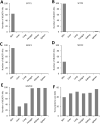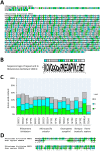Evolutionary diversification of epidermal barrier genes in amphibians
- PMID: 35948609
- PMCID: PMC9365767
- DOI: 10.1038/s41598-022-18053-7
Evolutionary diversification of epidermal barrier genes in amphibians
Abstract
The epidermal differentiation complex (EDC) is a cluster of genes encoding components of the skin barrier in terrestrial vertebrates. EDC genes can be categorized as S100 fused-type protein (SFTP) genes such as filaggrin, which contain two coding exons, and single-coding-exon EDC (SEDC) genes such as loricrin. SFTPs are known to be present in amniotes (mammals, reptiles and birds) and amphibians, whereas SEDCs have not yet been reported in amphibians. Here, we show that caecilians (Amphibia: Gymnophiona) have both SFTP and SEDC genes. Two to four SEDC genes were identified in the genomes of Rhinatrema bivittatum, Microcaecilia unicolor and Geotrypetes seraphini. Comparative analysis of tissue transcriptomes indicated predominant expression of SEDC genes in the skin of caecilians. The proteins encoded by caecilian SEDC genes resemble human SEDC proteins, such as involucrin and small proline-rich proteins, with regard to low sequence complexity and high contents of proline, glutamine and lysine. Our data reveal diversification of EDC genes in amphibians and suggest that SEDC-type skin barrier genes have originated either in a common ancestor of tetrapods followed by loss in Batrachia (frogs and salamanders) or, by convergent evolution, in caecilians and amniotes.
© 2022. The Author(s).
Conflict of interest statement
The authors declare no competing interests.
Figures




Similar articles
-
Development-Associated Genes of the Epidermal Differentiation Complex (EDC).J Dev Biol. 2024 Jan 15;12(1):4. doi: 10.3390/jdb12010004. J Dev Biol. 2024. PMID: 38248869 Free PMC article. Review.
-
Filaggrin has evolved from an "S100 fused-type protein" (SFTP) gene present in a common ancestor of amphibians and mammals.Exp Dermatol. 2017 Oct;26(10):955-957. doi: 10.1111/exd.13317. Epub 2017 May 2. Exp Dermatol. 2017. PMID: 28191671
-
Identification of epidermal differentiation genes of the tuatara provides insights into the early evolution of lepidosaurian skin.Sci Rep. 2020 Jul 30;10(1):12844. doi: 10.1038/s41598-020-69885-0. Sci Rep. 2020. PMID: 32732894 Free PMC article.
-
Evolutionary origin and diversification of epidermal barrier proteins in amniotes.Mol Biol Evol. 2014 Dec;31(12):3194-205. doi: 10.1093/molbev/msu251. Epub 2014 Aug 27. Mol Biol Evol. 2014. PMID: 25169930 Free PMC article.
-
Review: Evolution and diversification of corneous beta-proteins, the characteristic epidermal proteins of reptiles and birds.J Exp Zool B Mol Dev Evol. 2018 Dec;330(8):438-453. doi: 10.1002/jez.b.22840. Epub 2019 Jan 14. J Exp Zool B Mol Dev Evol. 2018. PMID: 30637919 Review.
Cited by
-
Comparative genomics of sirenians reveals evolution of filaggrin and caspase-14 upon adaptation of the epidermis to aquatic life.Sci Rep. 2024 Apr 23;14(1):9278. doi: 10.1038/s41598-024-60099-2. Sci Rep. 2024. PMID: 38653760 Free PMC article.
-
Development-Associated Genes of the Epidermal Differentiation Complex (EDC).J Dev Biol. 2024 Jan 15;12(1):4. doi: 10.3390/jdb12010004. J Dev Biol. 2024. PMID: 38248869 Free PMC article. Review.
-
Skin Appendage Proteins of Tetrapods: Building Blocks of Claws, Feathers, Hair and Other Cornified Epithelial Structures.Animals (Basel). 2025 Feb 6;15(3):457. doi: 10.3390/ani15030457. Animals (Basel). 2025. PMID: 39943227 Free PMC article. Review.
-
Comparative genomics of monotremes provides insights into the early evolution of mammalian epidermal differentiation genes.Sci Rep. 2024 Jan 16;14(1):1437. doi: 10.1038/s41598-024-51926-7. Sci Rep. 2024. PMID: 38228724 Free PMC article.
References
-
- Mischke D, Korge BP, Marenholz I, Volz A, Ziegler A. Genes encoding structural proteins of epidermal cornification and S100 calcium-binding proteins form a gene complex ("epidermal differentiation complex") on human chromosome 1q21. J. Invest. Dermatol. 1996;106:989–992. doi: 10.1111/1523-1747.ep12338501. - DOI - PubMed
Publication types
MeSH terms
Substances
Grants and funding
LinkOut - more resources
Full Text Sources

